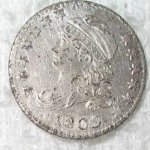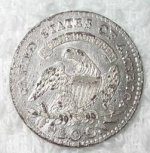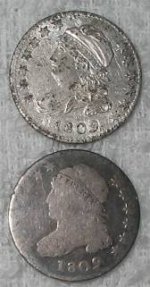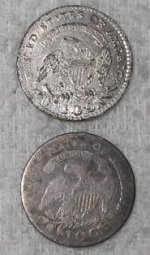Almost a decade ago, I found a 1809 Capped Bust Dime where I had found Spanish reales and colonial coppers. I was so excited by finding a key date dime that was actually this old. It looked like it was dropped not long after minted to me but had some funny marks or bubbles that on it. I thought well perhaps it was in a fire.
Anyway, I sent in to a company to be graded and they returned to me with simply a response 'cannot grade'. I wondered why but had to conclude it was counterfeit.
Then I wondered how does a counterfeit dime such as this find it way to where I found it? The more I looked at it, the more puzzled I became. How did someone back in those days counterfeit a dime to look so real? Upon final analysis, I decided it looked more like aluminum than silver and scrap the idea it was just in a fire. Then the question came to me - did they even have aluminum back in 1809? I don't think so. But another strange thing happened when I did research the metal.
"The story of aluminum’s history of use in the U.S. now stretches over 100 years. The start was a modest one, however. Because of the complexities of refining aluminum from ore, aluminum was considered more rare and precious than gold or silver through most of the 19th century. A pure form of the metal was first successfully extracted from ore in 1825 by Danish chemist Hans-Christian. Techniques to produce aluminum in ways modestly cost-effective emerged in 1889."
source: History of Aluminum
So it's obvious counterfeit. Has anyone else ever dug such a coin that you were thrilled about only to find it is a modern day counterfeit? I like to believe that someone in the 1800's used material that was more precious than gold or silver to make this coin, but somehow that really doesn't make much sense to me. Then I have to say thanks to whoever did bury this coin where I was repeatedly metal detecting - you gave me a real thrill.
Anyway, I sent in to a company to be graded and they returned to me with simply a response 'cannot grade'. I wondered why but had to conclude it was counterfeit.
Then I wondered how does a counterfeit dime such as this find it way to where I found it? The more I looked at it, the more puzzled I became. How did someone back in those days counterfeit a dime to look so real? Upon final analysis, I decided it looked more like aluminum than silver and scrap the idea it was just in a fire. Then the question came to me - did they even have aluminum back in 1809? I don't think so. But another strange thing happened when I did research the metal.
"The story of aluminum’s history of use in the U.S. now stretches over 100 years. The start was a modest one, however. Because of the complexities of refining aluminum from ore, aluminum was considered more rare and precious than gold or silver through most of the 19th century. A pure form of the metal was first successfully extracted from ore in 1825 by Danish chemist Hans-Christian. Techniques to produce aluminum in ways modestly cost-effective emerged in 1889."
source: History of Aluminum
So it's obvious counterfeit. Has anyone else ever dug such a coin that you were thrilled about only to find it is a modern day counterfeit? I like to believe that someone in the 1800's used material that was more precious than gold or silver to make this coin, but somehow that really doesn't make much sense to me. Then I have to say thanks to whoever did bury this coin where I was repeatedly metal detecting - you gave me a real thrill.

Attachments
Last edited:








